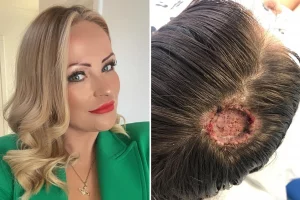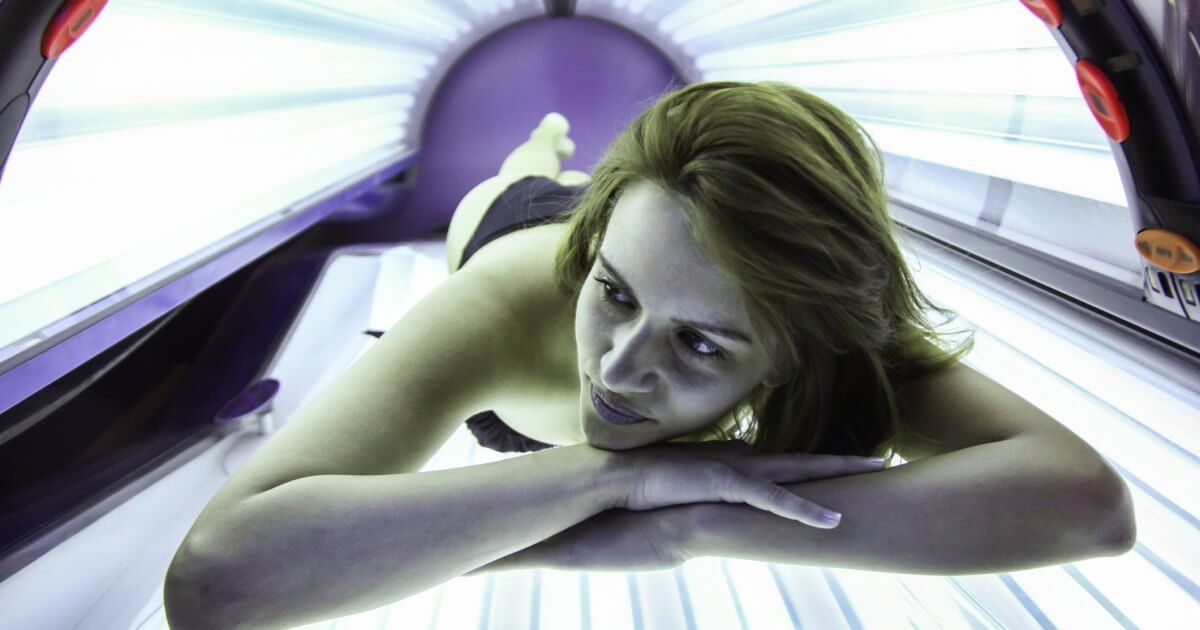Understanding the Risk of Tanning Salons
- Nickie Murtagh, 34, lives with a hole in her head after repeated sun exposure and tanning salon use led to her skin cancer diagnosis and treatment.
- No matter how vigilant you are about wearing sunscreen and decreasing your risk for skin cancer, its important to still prioritize routine checkups with your dermatologist and always be on the lookout for any skin changes in between visits.
- Tanning beds are dangerous because they expose you to the same harmful UVA/UVB rays you get from the sun, but in the bed these rays reach you from only 6-8 inches away. Studies have shown that exposure to tanning beds increases the risk of skin cancer and ocular cancer.
Murtagh, 36, was using sunbeds a couple times a week for eight to 12 minutes a session in her twenties. She also actively avoided using any sort of sun protection on her face because she didn’t want to “stop herself catching a tan.”
Read MoreBut at the dermatology office, Murtagh was met with a much different reaction to her lump.
“They told me they thought it was cancer straight away and biopsied me there and then,” she said. “While waiting for the results, my family stayed so positive and reassured me it was going to be fine and although the dermatologist thought it was cancer, I still wasn’t really expecting it.”
Seven weeks later, Murtagh received the news that she did, in fact have cancer basal cell carcinoma.
“When I heard the C word I instantly felt like my world was ending and I was going to die,” she said. “I worried about my kids and my family… It was terrifying.”
From there she had to decide on her course of treatment either radiotherapy or surgery.
“I chose surgery because it was less invasive and avoids the side effects that come with radiotherapy,” she said. “I just wanted it to be gone."
The surgery to remove the cancer was successful and a skin graft from her thigh was put into place, but now she’s left with a hole in her head and a scar on her thigh from the graft.

“It was awful. It looked like I had been shot in the head,” she said. “My hair hasn’t and won’t grow back in that area because the skin is from my thigh… And I have also lost all feeling in it."
Now, Murtagh wears SPF all year round and is determined to share her story as a cautionary tale to others.
“I am so much more cautious in the sun now, and I avoid sunbeds at all costs,” she said. “I am much more educated about sun damage and sun protection. I always wear a hat and I have SPF on every single day of the year… The sun doesn’t have to be hot to cause damage.”
What Is Basal Cell Carcinoma?
The three main types of skin cancer are melanoma, squamous cell carcinoma and basal cell carcinoma (BCC). Basal cell carcinoma the type of cancer Murtagh had is the most common form of skin cancer, and develops when basal cells, one of three main types of cells in the top layer of the skin, grow abnormally or uncontrollably.
One distinguishing factor of this type of skin cancer is that it tends to grow more slowly resulting in minimal damage and making it generally curable when caught and treated early. The tricky thing, however, is that BCC can often be overlooked as a pimple or skin tag. They may appear as raised areas on the skin with pale, pink or red-ish colors, and they may also have abnormal blood vessels. No matter what, if you have a spot on your skin that seems abnormal or questionable, you should consult your doctor because BCC can look very different from person to person.
Generally speaking, BCC occurs when DNA damage from exposure to ultraviolet (UV) radiation from the sun or indoor tanning triggers changes in basal cells. Because it most often develops on areas of the skin that are exposed to sun, it's crucial to protect yourself from the sun in any way that you can.
Protecting Yourself from Skin Cancer
The Skin Cancer Foundation estimates that over 5 million cases of skin cancer are diagnosed in the United States every year, making it the most common cancer in the United States. And even though most of us aren't soaking up the sun in a bathing suit at this time of year, it's important to remember that the risk of developing skin cancer is very much still there in the winter months.
Dr. Dendy Engelman, a board certified dermatologic surgeon at Shafer Clinic Fifth Avenue, previously spoke with SurvivorNet about the top five things you can do to avoid skin cancer:
- Avoid sun during peak hours: 10 a.m. to 2 p.m.
- Wear a wide brimmed hat and sunglasses to protect the tops of our heads, the tops of our ears and the delicate area around the eye.
- Wear at least SPF 30 sunscreen and make sure to reapply every two hours or after excessive sweating or swimming.
- Have yearly skin checks (with a professional) because it's difficult to evaluate areas all over the body.
- Avoid tanning beds. There are no "good" tanning beds, and they can significantly increase your risk of skin cancer.
Top 5 Ways to Protect Your Skin From Skin Cancer
No matter how vigilant you are about decreasing your risk for skin cancer, its important to still prioritize routine checkups with your dermatologist and always be on the lookout for any skin changes in between visits.
The Dangers of Tanning Beds
And if you're considering visiting a tanning bed during these cold winter months, we'd highly suggest you think again. Just one indoor tanning session can increase the risk of melanoma by 20 percent, squamous cell carcinoma by 67 percent and basal cell carcinoma by 29 percent, according to the American Academy of Dermatology.
When you hop into a tanning bed, you are exposing yourself to the very same dangerous rays you expose yourself to outside but they're only 6-8 inches away. And in a study recently published in Cancer, a peer-reviewed journal of the American Cancer Society, researchers suggest that banning tanning beds among minors would prevent thousands of cases of melanoma in adolescents, along with millions of dollars in healthcare costs.
So, even if the temptation of achieving a nice "glow" seems irresistible, you should note that health experts warn against using tanning beds.
"Studies have shown that exposure to tanning beds increases the risk of skin cancer and ocular cancer," says Dr. Lynn A. Cornelius, chief of the division of dermatology at Washington University School of Medicine in St. Louis. "It also induces changes that lead to premature aging of the skin. There is no 'safe' tanning bed."
Dr. Anna Pavlick, an oncologist specializing in skin cancer at Weill Cornell, echoed Dr. Cornelius' statements by explaining that tanning beds increase your chances of melanoma "exponentially."
Tanning Salons Pose a Big Risk for Skin Cancer
"We know there is a direct correlation with [melanoma] patients who go to indoor tanning salons," Dr. Pavlick tells SurvivorNet, who notes that the exposure "is about 6 inches from your body."
The sun is millions of miles away when you're on a beach, "so you have to think of the intensity that you're exposing your skin to when you go to a tanning salon," she says.
Alternatives to Tanning Beds
If achieving the perfect tan is very important to you, there are other options to try instead of the UV-blasting tanning beds or prolonged sun exposure. Temporary options like spray tans and self-tanning lotions are thought to be far better alternatives.
"Spray tans and sunless tanning lotions are safe," Dr. Cornelius says. "One should take precautions not to inhale the product when getting a spray tan. Skin allergic reactions are rare."
Spray tans are a much safer alternative to tanning beds, but Dr. Craig Elmets, professor in the Department of Dermatology at the University of Alabama at Birmingham School of Medicine, says that not much is known about the side effects of spray tans.
"They even have a very mild sunscreen effect," he says, adding that applying sunblock is still recommended when going outdoors. "Not a lot is known about the side effects, but there is very limited absorption and they have been available for decades without any reports of serious side effects, which is reassuring."
Self-tanning pills are another option for people seeking a golden glow, but tanning pills are not FDA-approved or endorsed by dermatologists. Dr. Elmets notes that they have also been associated with allergic reactions and systemic side effects.
Learn more about SurvivorNet's rigorous medical review process.


